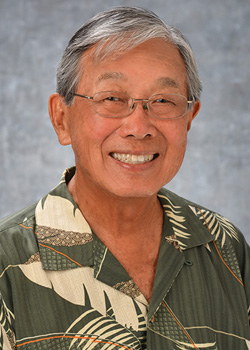Donald Goo joined the firm of Wimberly, and Cook in 1959 where he was later made partner. The firm would be renamed Wimberly Allison Tong & Goo (WATG). Donald Goo served the firm as President, CEO, and later, Chairman and led many prominent and noteworthy resort-based projects in Hawai‘i and internationally.
Donald Goo’s more than 50-year career as an architect, urbanist, industry leader, educator and mentor has been both exemplary and complex. From humble beginnings in Kalihi, Hawai‘i to leading the premier hospitality firm in the world while also along the way being named one of the 25 most admired architectural educators, a Fellow of the American Institute of Architects, and also being honored as a trail blazer with the Innovator of Hospitality Design co-award, his path has been diverse.
As an early pioneer of large-scaled architecture and urban projects Donald Goo is the first to point out that much of what we accomplish today transcends the individual. He credits the design teams he has worked closely with over the years for much of his and his firm, Wimberly, Allison, Tong & Goo, WATG’s success.
He speaks of lessons learned, responding to both the needs of a client as well as the needs of the community, and listening more than speaking. “My role has been to be an inspiration, to be the creator of concepts and to lead the team,” Don explains. To listen, interpret, visualize, and deliver. Picking up on his partner Jerry Allison’s words he comments that his architecture is deeply rooted in the idea of “a culture of place,” or as we now say, “a sense of place.”
Together with these teams and individuals he has achieved a high level of international design success: individuals such as Kevin Chun and Eugene Watanabe on the Hawai‘i Convention Center, Clint Nagata on Sheraton Maui; Manolo Quiason on the Sheraton Waikïkï; Kirk Potter on the Phenom Penh, Cambodia Casino and Hotel and, John Pharis on the Hilton Hawaiian Village, to name just a few.
He begins each project with the thought that most buildings require a gathering space or orienting space and that the environment in which his architecture is being situated should be enhanced and improved upon, often with the addition of trees, water and other natural elements. Urban environments are influenced by transportation, circulation and the scale of the surrounding built environment. The juxtaposition of open space to the built, public art, public amenities and the hard scape and landscape all play an important role in designing urban places.
“As an architect of tropical buildings, I am cognizant of the amount of natural light that influences the building’s exterior and its interior,” he points out. He is also influenced by the art that he and his team of designers incorporate into the architecture — art in architecture, he points out. “It’s the natural light that expresses the materials and space,” he says.
SIGNIFICANT PROJECTS:
1961 Simonson Residence
1965 Royal Hawaiian Hotel Wing Addition
1966 Bank of Hawaii Waikīkī Office
1967 Hawai‘i Kai Goo Residence
1968 Mauna Kea Beach Hotel, Mount Rainier Visitor Center Addition
1969 Royal Hawaiian Hotel Addition, Sheraton Waikīkī, Bank of Hawaii Kapahulu
1973 Punchbowl Apartments, Atherton Hālau at Bishop Museum, Waikōloa Golf Club, Sheraton Maui Addition
1983 Hanalei Beach and Raquet Club
1988 Hilton Hawaiian Village Master Plan
1989 Turtle Bay Renovation
1998 Hawai‘i Convention Center
2000 Kūhiō Beach Redevelopment
2002 Sheraton Wild Horse Pass Resort & Spa
